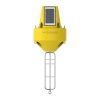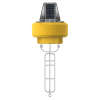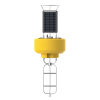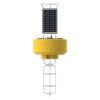NexSens CB-650 Data Buoy
Features
- Integrated 32-watt solar panels for 96-watts of solar charging
- Three 4" diameter sensor holes with female NPT threads for sensor deployment
- Topside plate supports solar marine light, weather stations, and other sensors
- Expedited repair and warranty service
- Lifetime technical support
- More
The NexSens CB-650 Data Buoy is designed for deployment in lakes, rivers, coastal waters, harbors, estuaries and other freshwater or marine environments. The floating platform supports both topside and subsurface environmental monitoring sensors including weather stations, wave sensors, thermistor strings, multi-parameter sondes, Doppler current profilers and other monitoring instruments.
The buoy is constructed of an inner core of cross-linked polyethylene foam with a tough polyurea skin. A topside 35” tall stainless steel tower includes three 32-watt 12VDC semi-flexible solar panels, and a center 10” ID x 21.5” tall data well accommodates batteries, data loggers, sensors, and more. Three 4” pass-through holes with female NPT bottom threads allow for quick connection of instrument deployment pipes and custom sensor mounts. The stainless steel frame supports both single point and multi-point moorings.
The CB-650 Data Buoy is optimized for use with NexSens X3 data loggers. Wireless telemetry options include global 4G LTE cellular, Iridium satellite, and global 4G LTE cellular with Iridium satellite fallback. Compatible digital sensor interfaces include RS-232, RS-485 and SDI-12. Each sensor port offers a UW receptacle connector with double O-ring seal for a reliable waterproof connection. For custom integrations, CB-PTL pass through and CB-MCL wet-mate data well lids are available.
- Hull Outer Diameter: 38.0” (96.5cm)
- Hull Height: 22.0” (55.9cm)
- Data Well Inner Diameter: 10.3” (26.2cm)
- Data Well Height: 21.5" (54.6cm)
- Pass-Through Hole Diameter: 4.0" (10.2cm)
- Tower Height: 35.0” (88.9cm)
- Solar Panels: 3x 32-watts
- Weight: 215 lb (98kg)
- Gross Buoyancy: 650 lb (295kg)
- Hull Material: Cross-linked polyethylene foam with polyurea coating & stainless steel deck
- Hardware Material: 316 stainless steel
- Mooring Attachments: 3x 3/4” eyenuts
- (1) CB-650 solar tower
- (1) CB-650 buoy hull
- (1) CB-CCA anti-rotation cage clamp
- (1) CAGE-L instrument cage
In The News
From Pans to Buoys: Advancing Reservoir Evaporation Rate Monitoring in Texas
In warmer climates like Texas, high reservoir evaporation rates can lead to declines in water level and water availability during droughts, making monitoring essential in order to ensure water security during times of scarcity. According to the Texas Water Development Board (TWDB), evaporation rates in Texas were previously based on data collected from a sparse network of Class A evaporation stations, dating back to the 1960s. These pans were stationed near reservoirs and still remain a widely accepted standardized approach to measuring evaporation rates on land. Monthly pan-to-lake coefficients were developed in the 1980s to connect the data collected from the pans to known lake conditions, extrapolating evaporation rates of the lakes using the pan data.
Read MoreMonitoring Lake Erie’s Eastern Basin: Building Long-Term Data and Real-Time Public Solutions
In the eastern basin of Lake Erie, off the coast of Dunkirk, New York, a data buoy collects valuable water quality, weather, and wave data that inform residents and regulatory groups of conditions on the water. Since 2011, Buffalo State University’s Great Lakes Center has maintained and operated the Dunkirk buoy with funding from the Great Lakes Observing System (GLOS) and field support from the NYSDEC Lake Erie Fisheries Research Unit. [caption id="attachment_38976" align="aligncenter" width="940"] The Dunkirk Buoy viewed from the research vessel after being deployed in early spring.
Read MoreMonitoring Buoy Supports Nautical Archaeology
For as long as humans have inhabited Europe’s Atlantic coast, the ocean has been a great source of wonder and mystery. History is full of fascinating tales of epic endeavors, new discoveries of fearless explorers, fishing communities inextricably linked to the bounties of the sea, cultural interactions both peaceful and not, and voyages that went awry during monumental storms or simply due to bad luck. In the south of Spain, at the boundary between the Atlantic Ocean and the Mediterranean Sea, one such tale involves a long-lost merchant ship that went undiscovered from the 16th century until 1984. Believed to be carrying valuable goods from Italy, it sank just across from Gibraltar in the Algeciras Bay at a point called La Ballenera.
Read More











































